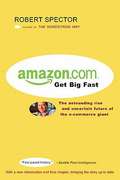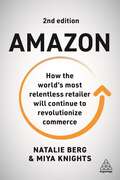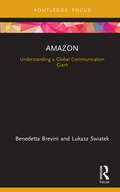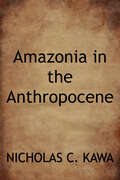- Table View
- List View
Amazon, Google, and Apple: Smart Speakers and the Battle for the Connected Home
by Scott Johnson Rajiv LalCase
Amazon.com
by Robert SpectorIn Amazon.com Jeff Bezos built something the world had never seen. He created the most recognized brand name on the Internet, became for a time one of the richest men in the world, and was crowned "the king of cyber-commerce."Yet for all the media exposure, the inside story of Amazon.com has never really been told. In this revealing, unauthorized account, Robert Spector, journalist and best-selling author, gives us this up-to-date, fast-paced, behind-the-scenes story of the company's creation and rise, its tumultuous present, and its uncertain future.
Amazon.com in the Year 2000
by Krishna G. Palepu Jeremy CottAn analyst's critique of Amazon's prospectus from the perspective of its bond holders.
Amazon.com's European Distribution Strategy
by Janice H. Hammond Claire ChironDescribes how Amazon's distribution system evolved from the company's inception. In 2003, Amazon Europe must decide how to reconfigure its distribution network in light of expected growth, products proliferation, and geographical expansion in Europe. Examines how characteristics of suppliers and customers differ across the markets Amazon serves in Europe. The protagonist must consider the degree of centralization appropriate for the European network, where inventory should be held, what fulfillment models should be used, and how to manage risks of supply disruption.
Amazon.com, 2016
by John R. Wells Galen Danskin Gabriel EllsworthOn January 28, 2016, Amazon announced record 2015 operating profits of $2.2 billion on $107 billion of sales, and the markets responded with cautious optimism. For years, founder and CEO Jeffrey Bezos had prioritized growth and investment in new business areas over profits, but pressure from analysts was mounting as growth was slowing and profits were failing to materialize. In 2014, Amazon had recorded a net loss of $241 million on revenues of $89 billion, in stark contrast to China's leading Internet player Alibaba, which reported $3.9 billion of net income on revenue of $12.3 billion. While Alibaba was a third-party marketplace with no distribution or inventory holding, Amazon's business model was more diverse. Amazon was primarily an online retail department store, offering a wide range of product categories, but it also maintained a significant third-party marketplace where it offered shipping, customer service, payment processing, and return services to independent retailers. Amazon also offered software and cloud storage services, online video streaming, and its own line of electronic hardware (mobile, e-reader, and smart television products). In addition, Amazon published books, hosted its own app store, funded video content development, and operated Amazon Prime, an annual membership program with a wide range of benefits. Indeed, Amazon's activities overlapped with those of Apple, Google, eBay, Alibaba, and many other companies. Amazon provided little information on the profitability of its lines of business, many of which were believed to be unprofitable. Which businesses would drive Amazon's future growth? Would the investments Amazon was making in market share eventually translate into profits? Or would another major competitor or business model replace Amazon? On a visit to the United States in June 2015, Jack Ma, chairman of Alibaba, stated, "We're not coming here to compete." Could Amazon or its investors afford to believe him?
Amazon.com, 2018
by John R. Wells Galen Danskin Gabriel EllsworthOn January 28, 2016, Amazon announced record 2015 operating profits of $2.2 billion on $107 billion of sales, and the markets responded with cautious optimism. For years, founder and CEO Jeffrey Bezos had prioritized growth and investment in new business areas over profits, but pressure from analysts was mounting as growth was slowing and profits were failing to materialize. In 2014, Amazon had recorded a net loss of $241 million on revenues of $89 billion, in stark contrast to China's leading Internet player Alibaba, which reported $3.9 billion of net income on revenue of $12.3 billion. While Alibaba was a third-party marketplace with no distribution or inventory holding, Amazon's business model was more diverse. Amazon was primarily an online retail department store, offering a wide range of product categories, but it also maintained a significant third-party marketplace where it offered shipping, customer service, payment processing, and return services to independent retailers. Amazon also offered software and cloud storage services, online video streaming, and its own line of electronic hardware (mobile, e-reader, and smart television products). In addition, Amazon published books, hosted its own app store, funded video content development, and operated Amazon Prime, an annual membership program with a wide range of benefits. Indeed, Amazon's activities overlapped with those of Apple, Google, eBay, Alibaba, and many other companies. Amazon provided little information on the profitability of its lines of business, many of which were believed to be unprofitable. Which businesses would drive Amazon's future growth? Would the investments Amazon was making in market share eventually translate into profits? Or would another major competitor or business model replace Amazon? On a visit to the United States in June 2015, Jack Ma, chairman of Alibaba, stated, "We're not coming here to compete." Could Amazon or its investors afford to believe him?
Amazon.com, 2019
by John R. Wells Galen Danskin Gabriel Ellsworth Benjamin WeinstockIn January 2019, Amazon.com Inc (Amazon) became the most valuable company in the world, above Microsoft, Apple, and Alphabet (Google). Jeff Bezos, Amazon's founder and CEO was now the world's richest man. On January 31st, 2019, Amazon announced 2018 operating profits of $12.4 billion, up from $178 million in 2014, on sales of $232 billion, up from $89 billion four years earlier. The shareholders expressed their satisfaction, but not all were happy with Amazon's meteoric rise. Many traditional retailers in the United States were going bankrupt, while major competitors such as Walmart and Best Buy were forced to invest aggressively in online retailing to prevent their market share from eroding. Every retail sector appeared to be under threat, fueling anxieties that Amazon and America's other tech giants were becoming too big and powerful. In the United States, Amazon was drawing criticism from across the political spectrum, with calls for it to be broken up. Meanwhile, the European Union was also investigating its practices. Did Amazon's success threaten its very existence?
Amazon.com, 2019
by John R. Wells Galen Danskin Gabriel EllsworthOn January 28, 2016, Amazon announced record 2015 operating profits of $2.2 billion on $107 billion of sales, and the markets responded with cautious optimism. For years, founder and CEO Jeffrey Bezos had prioritized growth and investment in new business areas over profits, but pressure from analysts was mounting as growth was slowing and profits were failing to materialize. In 2014, Amazon had recorded a net loss of $241 million on revenues of $89 billion, in stark contrast to China's leading Internet player Alibaba, which reported $3.9 billion of net income on revenue of $12.3 billion. While Alibaba was a third-party marketplace with no distribution or inventory holding, Amazon's business model was more diverse. Amazon was primarily an online retail department store, offering a wide range of product categories, but it also maintained a significant third-party marketplace where it offered shipping, customer service, payment processing, and return services to independent retailers. Amazon also offered software and cloud storage services, online video streaming, and its own line of electronic hardware (mobile, e-reader, and smart television products). In addition, Amazon published books, hosted its own app store, funded video content development, and operated Amazon Prime, an annual membership program with a wide range of benefits. Indeed, Amazon's activities overlapped with those of Apple, Google, eBay, Alibaba, and many other companies. Amazon provided little information on the profitability of its lines of business, many of which were believed to be unprofitable. Which businesses would drive Amazon's future growth? Would the investments Amazon was making in market share eventually translate into profits? Or would another major competitor or business model replace Amazon? On a visit to the United States in June 2015, Jack Ma, chairman of Alibaba, stated, "We're not coming here to compete." Could Amazon or its investors afford to believe him?
Amazon.com, 2021
by John R. Wells Galen Danskin Gabriel Ellsworth Benjamin WeinstockIn January 2019, Amazon.com Inc (Amazon) became the most valuable company in the world, above Microsoft, Apple, and Alphabet (Google). Jeff Bezos, Amazon's founder and CEO was now the world's richest man. On January 31st, 2019, Amazon announced 2018 operating profits of $12.4 billion, up from $178 million in 2014, on sales of $232 billion, up from $89 billion four years earlier. The shareholders expressed their satisfaction, but not all were happy with Amazon's meteoric rise. Many traditional retailers in the United States were going bankrupt, while major competitors such as Walmart and Best Buy were forced to invest aggressively in online retailing to prevent their market share from eroding. Every retail sector appeared to be under threat, fueling anxieties that Amazon and America's other tech giants were becoming too big and powerful. In the United States, Amazon was drawing criticism from across the political spectrum, with calls for it to be broken up. Meanwhile, the European Union was also investigating its practices. Did Amazon's success threaten its very existence?
Amazon.com--1994-2000
by Lynda M. Applegate Meredith ColluraEnables a thorough analysis of Amazon.com and the company's value proposition, in terms of its business concept, digital business capabilities, and community and shareholder value. Examines the company's complex set of business models and web of business relationships, as well as Amazon's plan to monetize (generate revenues and earnings through) its assets. A rewritten version of an earlier case.
Amazon.com--2002
by William A. Sahlman Michael J. Roberts Todd Thedinga Stig LeschlyDescribes the evolution of Amazon.com and its business model since its founding. Specifically, discusses Amazon's transformation from an e-Tailer to a commerce platform and its marketplace initiative, which has driven this. Also describes the economics of various commerce models that Amazon employs and discusses a decision confronting Jeff Bezos regarding how the company should participate in the apparel segment.
Amazon.com: Exploiting the Value of Digital Business Infrastructure
by Lynda M. Applegate Meredith ColluraEnables a thorough analysis of Amazon.com and the company's value proposition, in terms of its business concept, digital business capabilities, and community and shareholder value. Examines the company's complex set of business models and web of business relationships, as well as Amazon's plan to monetize (generate revenues and earnings through) its assets.
Amazon.com: Going Public
by William A. Sahlman Laurence E. KatzAmazon.com, an early pioneer in electronic commerce, prepares its initial public offering in the face of turbulent market conditions. Joy Covey, Amazon.com's CFO and the case protagonist, discusses the risks and opportunities of going public and the nature of electronic commerce business models in comparison to traditional land-based retail models. This case presents an opportunity to discuss the public offering process and the inter-relationship between a young company's financing strategy and business strategy.
Amazon.com: The Brink of Bankruptcy
by Lynda M. ApplegateEnables a thorough analysis of the Amazon.com business model and its evolution from 1994 to 2001. The case ends with the company poised on the brink of bankruptcy, and enables discussion of how to turnaround the company and leverage proprietary assets.
Amazon: Cult or Culture?
by Boris Groysberg Sarah L. Abbott Tricia GreggAmazon was one of the first entrants in e-commerce. Under the leadership of founder Jeff Bezos, Amazon had expanded beyond books to manufacturing and selling a wide range of products and services globally. Bezos had built a customer-centric culture that permeated all aspects of the company. As Amazon continued to grow and expand into new business areas, would it be able to maintain its culture and practices? How much of Amazon's success depended on the cult of Bezos? As the company continued to diversify beyond Bezos's immediate oversight, what could Amazon do to ensure that it stayed relentless?
Amazon: How the World’s Most Relentless Retailer will Continue to Revolutionize Commerce
by Natalie Berg Miya KnightsThe retail industry is facing unprecedented challenges. Across all sectors and markets, retailers are shifting their business models and customer engagement strategies to ensure their survival. The rise of online shopping, and its primary player, Amazon, is at the heart of many of these changes and opportunities. Amazon explores the e-commerce giant's strategies, providing original insight at a time when the company is on the cusp of revolutionizing itself even further. Amazon's relentless dissatisfaction with the status quo is what makes it such an extraordinary retailer. This book explores whether Amazon has what it takes to become a credible grocery retailer, and as it transitions to bricks and mortar retailing, explores whether Amazon's stores can be as compelling as its online offering and if innovations such as voice technology, checkout-free stores and its Prime ecosystem will fundamentally change the way consumers shop.Written by industry leading retail analysts who have spent decades providing research-based analysis and opinion, Amazon analyzes the impact these initiatives will have on the wider retail sector and the lessons that can be learned from its unprecedented rise to dominance, as stores of the future become less about transactions and more about experiences.
Amazon: How the World’s Most Relentless Retailer will Continue to Revolutionize Commerce
by Natalie Berg Miya KnightsAmazon - one of the world's most valuable companies - is worth more than Walmart, Netflix, Target, Nike and Costco combined. What are the secrets to its success? How can these insights be applied to other businesses in the e-commerce sector? The retail industry is facing unprecedented challenges. Across all sectors and markets, retailers are shifting their business models and customer engagement strategies to ensure they survive. Amazon offers unique insight into the company's persistent dissatisfaction with the status quo and innovation and how it has fundamentally changed the ways in which we shop. This fully updated second edition explores Amazon's response to the coronavirus pandemic, the convergence of physical and digital retail, e-commerce economics and sustainability, as well as future policy implications. Written by industry-leading retail analysts and with the first edition now translated into more than a dozen languages, Amazon is an invaluable resource for discovering the lessons that can be learned from the company's unprecedented rise to dominance.
Amazon: Managing Extraordinary Success in 5-D Value
by Benjamin WallIn Amazon: Managing Extraordinary Success in 5-D Value, Benjamin Wall offers structured insights into strategically managing value in the key relationships to customers, personnel, business partners, and investors in order to improve value management at any company.The extraordinary success of Amazon is due to market-leading strength in three &“dimensions&” of value: owning the mightiest supply chain to deliver fastest and cheapest the broadest range of products, enhancing what customers and business partners are doing when using the website / online ecosystem, and knowing how to implement the optimal terms and conditions in the after-sales customer experience. Wall takes a look at the unique managerial skill of Amazon and how each of these organizational areas operates externally and internally according to a separate business logic based on a dimension of value.In an original examination, Wall systematically evaluates Amazon by categorizing and connecting its external and internal success factors to dimensions of value. Each &“score&” on an external success factor is linked to an internal success factor in managing processes, organizational culture, and the business model, so that managers and leaders can enhance their own internal success factors and move towards the same successful external factors. Amazon looks to the future where the near-term promise of the company is evaluated to be in the development from online to omnichannel retail, including the sale of services, by reviving out of Amazon&’s past the fourth dimension of value: feeling how to integrate value. The long-term potential of Amazon is set in the context of a sustainable future for retail, based on trends arising today in meaning across multiple communities, which is the emerging fifth dimension of value. Amazon is projected to operate in this value dimension again as a disruptor, and with Wall&’s help, managers and leaders can reach for the same kind of success.
Amazon: Pollen Manual and Atlas
by Paul A Collinvaux Paulo E. De Oliveira Enrique MorenoAmazon will prove a powerful tool for ecologists and climate modelers. It also contains brief reviews of pioneering pollen work in the Amazon to date; sections on pollen methods, pollen statistics, paleoecology, and lake coring methods.
Amazon: The Brink of Bankruptcy
by Lynda M. ApplegateEnables a thorough analysis of the Amazon.com business model and its evolution from 1994 to 2001. The case ends with the company poised on the brink of bankruptcy, and enables discussion of how to turnaround the company and leverage proprietary assets.
Amazon: The Brink of Bankruptcy
by Lynda M. ApplegateEnables a thorough analysis of the Amazon.com business model and its evolution from 1994 to 2001. The case ends with the company poised on the brink of bankruptcy, and enables discussion of how to turnaround the company and leverage proprietary assets.
Amazon: Understanding a Global Communication Giant (Global Media Giants)
by Benedetta Brevini Lukasz SwiatekTaking a political economy of media approach, this book examines Amazon as a significant actor in the global media landscape. Amazon is mainly conceived in the popular consciousness and media commentary as a corporate body, selling products and services to individual consumers and organisations, but Brevini and Swiatek show that Amazon has become a communication giant that trades in diversified media (its own and others), and exerts a significant influence on global communication, especially through its online services. Further, the authors provide evidence of Amazon's multiple influences on politics, economics, and culture. With its comprehensive and critical overview, this book is ideal for students, scholars, and researchers of media and communication studies and political economy.
AmazonFresh: Rekindling the Online Grocery Market
by Clayton M. Christensen Rory Mcdonald Robin Yang Ty HollingsworthMore than a decade after the high-profile failures of several early online grocers, grocery remains the largest single U.S. retail category and one of the few that has not yet migrated online. Amazon began testing its grocery-delivery service, AmazonFresh, in Seattle, in 2007; five years later, the company has made significant progress. The case traces the evolution of AmazonFresh's business model and describes the operating capabilities necessary to compete with brick-and-mortar supermarkets like Wal-Mart and Safeway and with new digital grocery startups. Now Amazon needs to decide on AmazonFresh's next step. Should the company continue refining its business model in Seattle or expand to another city? What factors should it take into account when planning its next move?
Amazonia and Global Change
by Pedro Silva Dias Mercedes Bustamante John Gash Michael KellerPublished by the American Geophysical Union as part of the Geophysical Monograph Series, Volume 186.Amazonia and Global Change synthesizes results of the Large-Scale Biosphere-Atmosphere Experiment in Amazonia (LBA) for scientists and students of Earth system science and global environmental change. LBA, led by Brazil, asks how Amazonia currently functions in the global climate and biogeochemical systems and how the functioning of Amazonia will respond to the combined pressures of climate and land use change, such asWet season and dry season aerosol concentrations and their effects on diffuse radiation and photosynthesisIncreasing greenhouse gas concentration, deforestation, widespread biomass burning and changes in the Amazonian water cycleDrought effects and simulated drought through rainfall exclusion experimentsThe net flux of carbon between Amazonia and the atmosphereFloodplains as an important regulator of the basin carbon balance including serving as a major source of methane to the troposphereThe impact of the likely increased profitability of cattle ranching.The book will serve a broad community of scientists and policy makers interested in global change and environmental issues with high-quality scientific syntheses accessible to nonspecialists in a wide community of social scientists, ecologists, atmospheric chemists, climatologists, and hydrologists.
Amazonia in the Anthropocene: People, Soils, Plants, Forests
by Nicholas C. KawaWidespread human alteration of the planet has led many scholars to claim that we have entered a new epoch in geological time: the Anthropocene, an age dominated by humanity. <p><p>This ethnography is the first to directly engage the Anthropocene, tackling its problems and paradoxes from the vantage point of the world's largest tropical rainforest. Drawing from extensive ethnographic research, Nicholas Kawa examines how pre-Columbian Amerindians and contemporary rural Amazonians have shaped their environment, describing in vivid detail their use and management of the region's soils, plants, and forests. At the same time, he highlights the ways in which the Amazonian environment resists human manipulation and control--a vital reminder in this time of perceived human dominance. <p><p>Written in engaging, accessible prose, Amazonia in the Anthropocene offers an innovative contribution to debates about humanity's place on the planet, encouraging deeper ecocentric thinking and a more inclusive vision of ecology for the future.








